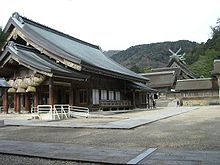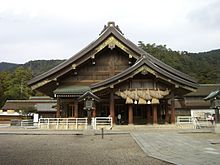Izumo Taisha

Izumo-Taisha ( Japanese 出 雲 大 社 ; the official reading is Izumo no Ōyashiro , literally Grand Shrine of Izumo ) is one of the oldest and most important Shinto shrines in Japan . He belongs to the Chokusaisha . In it, the “ god of medicine ” Ō-kuni-nushi -no-mikoto is worshiped as the main kami .
It is located in the district of the city Taisha Izumo in Shimane Prefecture .
history
There are no records of the exact original construction date. The oldest Japanese scripts, the Kojiki and Nihonshoki , date the origins of the shrine back to the mythical Kami age. The construction site is said to be identical to the mythical place where, according to Kojiki, Susanoo drew a fence made of clouds to retire to with his wife Kushinadahime .
The priesthood at the shrine is hereditary and is passed on in the Senge ( 千家 ) and Kitajima ( 北島 ) families - a single family until the second half of the 14th century (but in fact only in the Senge family). The office of high priest (here with the otherwise secular title of provincial governor kokuzō or kuni-no-miya-tsu-ko ) is said to have been in the 17th generation at the beginning of the fifth century. According to legend, the first high priest was Ame-no-hohi-no-mikoto, the second son Amaterasu , a kami born from their precious stones. The 17th high priest, Miyamoke-no-sukune, is venerated in a separate shrine, the Ujino-yashiro .
Below the high priest there are still kyōtō (teacher), then the two gon-gūji (assistant high priest), the negi and their assistants ( gon-negi ), including the kujō and finally the shuten . Within the families, special breathing techniques and other spiritual exercises (such as the obscure mu-nen ) are passed on and practiced in a special straw hut ( o-hido-koro ) on the shrine area.
The Izumo Taisha was and still is the center of the Shinto sect Izumo Ōyashiro-kyō , whose president ( kanchō ) is also the kyōtō of the shrine.
The history of the Izumo Taisha is marked by strong rejection of Buddhist influence. Buddhist idols were never placed in the shrine (rare for Shinto shrines). Already in 1662, long before the Shinbutsu-Bunri , the daimyo Matsudaira Naomasa (a grandson of Tokugawa Ieyasu ) had expelled all Buddhist priests from the shrine.
construction
A statue of the cow breeder-Kami Ushikai-jin (also Waka-futsu-nushi-no-kami) is inside the honden . A certain architectural style, taisha-zukuri ( 大 社 造 ), owes its name to the honden of Izumo-Taisha. This hall (the last new building dates from 1744) and a lacquered box are national treasures of Japan and other buildings and objects are important national cultural assets . Near the honden is the miki , a well whose water is only used for the preparation of the food offerings ( shinsen ). The guest kami ( aidono-no-kami ) in honden include Umashi-ashi-kabi-hiko-ji and Ame-no-toko-tachi.
In the Harai -no -yashiro (a massha ) the four purification-kami ( Harai-no-kami ) become Haya-aki-tsu-hime-no-mikoto, I-buki-do-nushi-no-kami, Se-oritsu -hime and Haya-sasura-hime-no-kami.
The individual sections of the shrine are separated from each other by fences, which have special names here: the outermost is called ara-gaki , the one after that is mizu-gaki and tama-gaki . The shrine's lake also has a special name: kiyome-no-ike (in other shrines: shin-chi ). The same goes for the cooking hall, usually shinsen-den , here shinsen-shō .
Probably the entire complex was considerably larger in earlier times and stood on a high platform, which recent archaeological finds of very old and large columns suggest.
Festivals
On the night of August 14th to 15th, the kami undertakes a ride ( minor ) to the shrines of Minato and Akahito, as well as to the holy beach of Shiotaki. The residents of these places traditionally go to bed early and turn off all lights so as not to see the kami. On the day of August 15, the Tsumamagi-sai is celebrated on the Izumo-Taisha. For this purpose, a special shinsen is prepared for the kami , u. a. consisting of half a lemon on a willow branch, from which the pulp was removed and the resulting cavity was filled with water. In addition, there is no meat, egg or alcohol in this shinsen .
Since the year 709 the Yone-ura-sai has been taking place on January 15th , a divination ceremony similar to the Okayu-ura-go-shinji at the Hiraoka Shrine in Osaka.
On the morning of November 26th, there is a harvest thanksgiving ceremony called kenkoku-sai . Peasants offer small bags of rice to the kami. At the end of the ceremony there is a lottery under the supervision of a special priest ( tengi ). The farmers can win three prizes: a Kami statue made of gold ( kin-go-zō ), made of silver ( gin-go-zō ) or made of wood ( on-zō ).
On the evening of November 26th, the Koden-shinjō-sai takes place in the haiden in honor of the high priest. This festival originally came from the Kumano Shrine, was then transferred to the Kamosu Shrine in Oba in the 16th century and finally found its current location in the Izumo Taisha after the Meiji Restoration . The high priest sits on a perch that resembles a sea lion and solemnly lights a fire with ancient rites using a wooden board ( hi-kiri-usu ) and a wooden stick ( hi-kiri-gine ). He then uses it to cook rice and three stones from the village of Manai, after which he pretends to bite into them ( hagatame ). He and two other priests are then offered 200 bulky shrub branches ( tagusa ) from nearby Uga-yama in a special ceremony. Meanwhile, seven other priests sit around a koto -ita , which they beat with willow twigs and sing the Aun-no-kokyū , which is strikingly similar to the Hindu Om , 50 times . Then one of them sings “ Sume-kami-o-matsurishi Asuyoyiwa ”, to which the other six respond with “ Asuyoyiwa akeno-koromo-okegoromo sen ”, which translated means something like: “On this auspicious day, Oh Kami, we celebrated the matsuri . From now on let us wear fine (red) clothes every day [since the harvest was good] ”. At the end of the ceremony, a negi circles a large cauldron ( ō-kama-sama ) in the haiden three times, carrying two bundles of rice and a red pot ( heishi ) on a stick and continuously saying “ ana-tanushi ” (“how joyful!”) ) sings.
According to legend, on October 11th all kami (except for the deaf) leave their normal shrines and take a trip to Izumo, first to the Izumo-Taisha (where they stay in two long halls in the Juku-sha until October 17th ), then to Sada-no-yashiro and finally to Mankusen-no-yashiro. For this reason, the month of October is known as the “month full of kami” ( kami-ari-zuki ) in Izumo , but in the rest of Japan it is known as the “month without kami” ( kami-na-zuki ). Farewell ceremonies are celebrated in almost all shrines on October 11th, but celebrations for their return hardly take place because it is believed that this date varies from year to year. Some kami, it is said, stay in Izumo until February of the following year.
literature
- Taryo Obayashi and Yoshio Watanabe: Ise and Izumo: the shrines of Shintoism . Herder publishing house , Freiburg im Breisgau / Basel / Vienna 1982, ISBN 3-451-19516-X .
- Jean Herbert: Shintô. At The Fountain-Head of Japan . George Allen & Unwin, 1967.
Web links
- Official website of the Izumo Taisha (Japanese)
- Shimane Prefecture Information Service (English)
- taisha-zukuri 大 社 造 in the Japanese Architecture and Art Net Users System (English)
- Hirai Naofusa: "Izumo Shinko" . In: Encyclopedia of Shinto. Kokugaku-in , November 11, 2006 (English)
- Pictures of the Izumo Taisha - more photos of the Izumo Taisha
Individual evidence
- ^ Heidrun Reißenweber: Japanese Medicine. In: Werner E. Gerabek , Bernhard D. Haage, Gundolf Keil , Wolfgang Wegner (eds.): Enzyklopädie Medizingeschichte. Walter de Gruyter, Berlin and New York 2005, ISBN 3-11-015714-4 , pp. 688-694, here (on Ôkuni-nushi-no-mikoto): pp. 688 f.
- ^ Bernhard Scheid: The large shrine of Izumo. In: Religion in Japan. April 10, 2009, accessed September 20, 2010 .
Coordinates: 35 ° 24 '7.2 " N , 132 ° 41' 7.7" E





